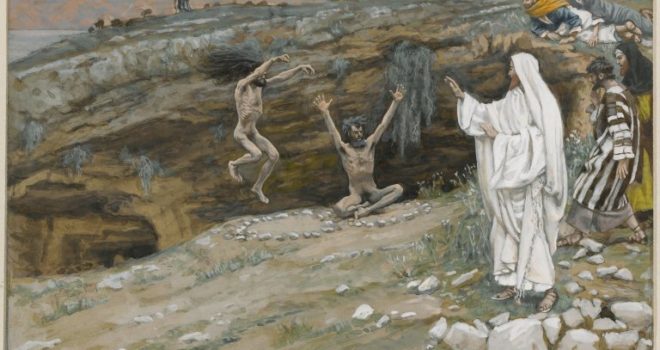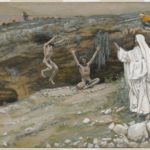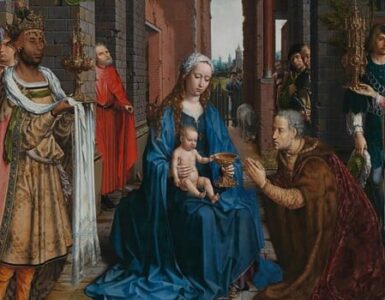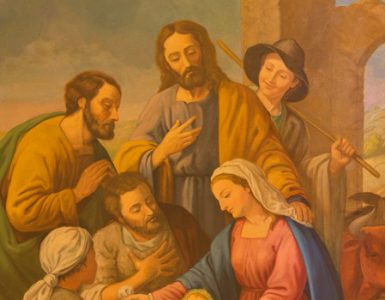Viewing and pondering sacred art offers the faithful a great way to meditate more deeply on the life and ministry of Jesus Christ. This series of articles will highlight several pieces of art related to the Luminous Mysteries of the Rosary, which highlight Our Lord’s public ministry. Each of these pieces of art allows us to reflect on Jesus’ teachings and miracles, connecting them more fully to our own lives.
Jesus’ proclamation of the Kingdom of God, which makes up the Third Luminous Mystery of the Rosary, allows us to meditate on the years that the Lord “went about all Galilee, teaching…and preaching the gospel of the Kingdom and healing every disease and every infirmity among the people” (Mt. 4:23). We know that He gave the Sermon on the Mount, as the entrée and summation of his teaching about the moral and spiritual life. But after He gave this memorable sermon, he went around the region curing illnesses and deformities and casting out demons.
Jesus’ first recorded healings and exorcisms, at least in Matthew’s Gospel account, happened in Capernaum (see Mt. 8:1-17). From Capernaum, Jesus entered a boat on the Sea of Galilee for a nocturnal voyage, where he brought “great calm” to the wind and the waves (see Mt. 8:23-27). On that eastern shore of the sea, somewhere near the Decapolis, Jesus entered “the country of the Gadarenes,” healed two demoniacs, and sent a heard of swine barreling quickly into the sea (see Mt. 8:28-34). This biblical episode is one of the most startling in all the Gospel narratives.
Jacques Tissot, a French artist of the late-nineteenth century, painted many scenes from those Gospel narratives throughout his career. One of those is Two Men Possessed with Devils, from the early-1890s. His depiction of this miraculous exhibition of divine power offers viewers a memorable way to visualize this moment in Jesus’ public ministry, and to apply its lessons to their own daily lives.

Jesus is in the foreground of the scene, dressed totally in white. Clearly, the artist meant for this to signify His purity and perfection, especially in contrast to the demon-possessed men at the center of the scene. His right arm and hand are raised to the posture of casting out evil spirits and providing a blessing. This offers viewers, those of us who long to be better disciples of the Lord, an opportunity to ask a probing question: Do I hold fast to the conviction that Jesus is both pure and powerful at all times? Do I believe that He can share that purity and power with me, to change and strengthen my life? Ultimately, each of us has things that need to be cast out from our lives, and which we are incapable of casting out fully without the grace and help of Our Blessed Lord.
Jesus’ attention is directly on the two demoniacs, who are completely naked, unkempt, and making wild gestures toward the Son of God and the few curious bystanders. We can almost hear their question, recorded by St. Matthew: “What have you to do with us, O Son of God? Have you come here to torment us before the time?” (Mt. 8:29). These men and their reaction provide an important window into our own spiritual lives. While we may not be possessed by demons, we certainly find ourselves under attack by the enemy and his minions. These attacks are best combatted by the sacraments, a deep and abiding prayer life, and a robust understanding of the moral principles given by Jesus and the Church. Beyond this, each of us may ask ourselves if there are patterns in our lives that cause us to be spiritually disheveled or filthy. What about our reactions when the grace and power of God come up against our sinful tendencies? Do we lash out in pride or envy or anger, tormented by the Lord’s light and love?
Tissot depicts a few curious bystanders near Jesus and the demoniacs. These must be the local citizens who would not even enter this vicinity because these two demoniacs were “so fierce” (Mt. 8:28). We notice immediately, though, that Jesus stands between them and the dangerous men. Now, a couple lounges on the grass, curiously looking at the rocky cleft where the tombs resided, and watching the possessed men. Another man looks like he is ready to move closer to the demoniacs. As we ponder the scene, this might cause each of us to reflect on moments when we have found courage to say or do something, with Jesus Christ as our shield and sword, that we could not say or do previously.
On the other side of the cleft, at the top-left of the scene, stands a shepherd with the “herd of many pigs” that was “feeding at some distance” from the main characters of the scene. When the demons asked Our Lord to be sent into the herd of swine, Jesus commanded, “Go.” (Mt. 8:30-32). The reaction of the herdsmen was to flee into the nearby town, where “they told everything” (Mt. 8:33). What is our reaction to the miracles we see Our Blessed Lord working in our vicinity? Do I doubt? Am I cynical? Do I simply keep quiet? Or, do I freely share with others about the amazing things I have witnessed?
Although it is not explicitly depicted by Tissot, the response of the townspeople is also important for a moment’s reflection. “And behold, all the city came out to meet Jesus….” If the passage ended there, we might think that people coming out to meet the Miracle Worker was a normal reaction to such a show of miraculous might. Yet, the narrative continues: “and when they saw him, they begged him to leave their region” (Mt. 8:34). This reaction ought to cause each of us to pause and ponder. Am I afraid of letting Jesus come closer to work more miracles? Would I prefer to handle things myself, even if that means that the status quo remains? Has there ever been a time that I have rejected Jesus’ offer to be present and provide healing?
So, Tissot’s depiction of this biblical event creates an important moment and space. Each of us who gazes upon the painting has an opportunity to reflect on the things that influence and control us. It also allows us to ask how we might overcome that influence, realizing that we cannot accomplish any of it by ourselves. Finally, we have the opportunity to ponder Jesus’ position in our lives, and if we are ready and able to courageously share with others what Our Blessed Lord has so graciously and powerfully done for us.
✠
Two Men Possessed with Devils is in the public domain.












